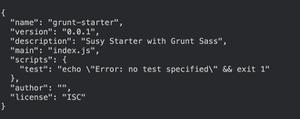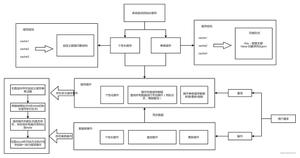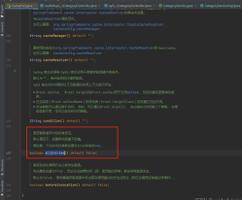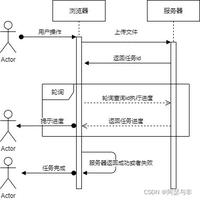spring中的aop注解(整合junit测试)
本文内容纲要:
- 使用spring中的aop前先来了解一下spring中aop中的一些名词- 一:不使用spring的aop注解
- 二:使用spring的aop注解
使用spring中的aop前先来了解一下spring中aop中的一些名词
Joimpoint(连接点):目标对象中,所有可能增强的方法
PointCut(切入点):目标对象,已经增强的方法
Advice(通知/增强):增强的代码
Target(目标对象):被代理对象
Weaving(织入):将通知应用到切入点的过程
Proxy(代理):将通知织入到目标对象之后,形成代理对象
aspect(切面):切入点+通知
一:不使用spring的aop注解
以javaEE中的service层为例
UserService.java:被代理对象
public interface UserService { void save();
void delete();
void update();
void find();
}
UserServiceImpl.java:被代理对象的实现类
public class UserServiceImpl implements UserService { @Override
public void save() {
System.out.println("保存用户!");
//int i = 1/0;
}
@Override
public void delete() {
System.out.println("删除用户!");
}
@Override
public void update() {
System.out.println("更新用户!");
}
@Override
public void find() {
System.out.println("查找用户!");
}
}
MyAdvice.java:通知,增强的代码
//通知类public class MyAdvice {
//前置通知
// |-目标方法运行之前调用
//后置通知(如果出现异常不会调用)
// |-在目标方法运行之后调用
//环绕通知
// |-在目标方法之前和之后都调用
//异常拦截通知
// |-如果出现异常,就会调用
//后置通知(无论是否出现 异常都会调用)
// |-在目标方法运行之后调用
//----------------------------------------------------------------
//前置通知
public void before(){
System.out.println("这是前置通知!!");
}
//后置通知
public void afterReturning(){
System.out.println("这是后置通知(如果出现异常不会调用)!!");
}
//环绕通知
public Object around(ProceedingJoinPoint pjp) throws Throwable {
System.out.println("这是环绕通知之前的部分!!");
Object proceed = pjp.proceed();//调用目标方法
System.out.println("这是环绕通知之后的部分!!");
return proceed;
}
//异常通知
public void afterException(){
System.out.println("出事啦!出现异常了!!");
}
//后置通知
public void after(){
System.out.println("这是后置通知(出现异常也会调用)!!");
}
}
applicationContext.xml
<?xml version="1.0" encoding="UTF-8"?><beans xmlns:xsi="http://www.w3.org/2001/XMLSchema-instance" xmlns="http://www.springframework.org/schema/beans" xmlns:context="http://www.springframework.org/schema/context" xmlns:aop="http://www.springframework.org/schema/aop" xsi:schemaLocation="http://www.springframework.org/schema/beans http://www.springframework.org/schema/beans/spring-beans-4.2.xsd http://www.springframework.org/schema/context http://www.springframework.org/schema/context/spring-context-4.2.xsd http://www.springframework.org/schema/aop http://www.springframework.org/schema/aop/spring-aop-4.2.xsd ">
<!-- 准备工作: 导入aop(约束)命名空间 -->
<!-- 1.配置目标对象 -->
<bean name="userService" class="cn.itcast.service.UserServiceImpl" ></bean>
<!-- 2.配置通知对象 -->
<bean name="myAdvice" class="cn.itcast.d_springaop.MyAdvice" ></bean>
<!-- 3.配置将通知织入目标对象 -->
<aop:config>
<!-- 配置切入点
public void cn.itcast.service.UserServiceImpl.save()
void cn.itcast.service.UserServiceImpl.save()
* cn.itcast.service.UserServiceImpl.save()
* cn.itcast.service.UserServiceImpl.*()
* cn.itcast.service.*ServiceImpl.*(..)
* cn.itcast.service..*ServiceImpl.*(..)
-->
<aop:pointcut expression="execution(* cn.itcast.service.*ServiceImpl.*(..))" id="pc"/>
<aop:aspect ref="myAdvice" >
<!-- 指定名为before方法作为前置通知 -->
<aop:before method="before" pointcut-ref="pc" />
<!-- 后置 -->
<aop:after-returning method="afterReturning" pointcut-ref="pc" />
<!-- 环绕通知 -->
<aop:around method="around" pointcut-ref="pc" />
<!-- 异常拦截通知 -->
<aop:after-throwing method="afterException" pointcut-ref="pc"/>
<!-- 后置 -->
<aop:after method="after" pointcut-ref="pc"/>
</aop:aspect>
</aop:config>
</beans>
Demo.java:整个junit的aop测试类
@RunWith(SpringJUnit4ClassRunner.class)@ContextConfiguration("classpath:cn/itcast/d_springaop/applicationContext.xml")
public class Demo {
@Resource(name="userService")
private UserService us;
@Test
public void fun1(){
us.save();
}
}
二:使用spring的aop注解
以javaEE中的service层为例
UserService.java:被代理对象
public interface UserService { void save();
void delete();
void update();
void find();
}
UserServiceImpl.java:被代理对象的实现类
public class UserServiceImpl implements UserService { @Override
public void save() {
System.out.println("保存用户!");
//int i = 1/0;
}
@Override
public void delete() {
System.out.println("删除用户!");
}
@Override
public void update() {
System.out.println("更新用户!");
}
@Override
public void find() {
System.out.println("查找用户!");
}
}
MyAdvice.java:通知类
//通知类@Aspect
//表示该类是一个通知类
public class MyAdvice {
@Pointcut("execution(* cn.itcast.service.*ServiceImpl.*(..))")
public void pc(){}
//前置通知
//指定该方法是前置通知,并制定切入点
@Before("MyAdvice.pc()")
public void before(){
System.out.println("这是前置通知!!");
}
//后置通知
@AfterReturning("execution(* cn.itcast.service.*ServiceImpl.*(..))")
public void afterReturning(){
System.out.println("这是后置通知(如果出现异常不会调用)!!");
}
//环绕通知
@Around("execution(* cn.itcast.service.*ServiceImpl.*(..))")
public Object around(ProceedingJoinPoint pjp) throws Throwable {
System.out.println("这是环绕通知之前的部分!!");
Object proceed = pjp.proceed();//调用目标方法
System.out.println("这是环绕通知之后的部分!!");
return proceed;
}
//异常通知
@AfterThrowing("execution(* cn.itcast.service.*ServiceImpl.*(..))")
public void afterException(){
System.out.println("出事啦!出现异常了!!");
}
//后置通知
@After("execution(* cn.itcast.service.*ServiceImpl.*(..))")
public void after(){
System.out.println("这是后置通知(出现异常也会调用)!!");
}
}
applicationContext.xml
<?xml version="1.0" encoding="UTF-8"?><beans xmlns:xsi="http://www.w3.org/2001/XMLSchema-instance" xmlns="http://www.springframework.org/schema/beans" xmlns:context="http://www.springframework.org/schema/context" xmlns:aop="http://www.springframework.org/schema/aop" xsi:schemaLocation="http://www.springframework.org/schema/beans http://www.springframework.org/schema/beans/spring-beans-4.2.xsd http://www.springframework.org/schema/context http://www.springframework.org/schema/context/spring-context-4.2.xsd http://www.springframework.org/schema/aop http://www.springframework.org/schema/aop/spring-aop-4.2.xsd ">
<!-- 准备工作: 导入aop(约束)命名空间 -->
<!-- 1.配置目标对象 -->
<bean name="userService" class="cn.itcast.service.UserServiceImpl" ></bean>
<!-- 2.配置通知对象 -->
<bean name="myAdvice" class="cn.itcast.e_annotationaop.MyAdvice" ></bean>
<!-- 3.开启使用注解完成织入 -->
<aop:aspectj-autoproxy></aop:aspectj-autoproxy>
</beans>
Demo.java:测试类
@RunWith(SpringJUnit4ClassRunner.class)@ContextConfiguration("classpath:cn/itcast/e_annotationaop/applicationContext.xml")
public class Demo {
@Resource(name="userService")
private UserService us;
@Test
public void fun1(){
us.save();
}
}
本文内容总结:使用spring中的aop前先来了解一下spring中aop中的一些名词,一:不使用spring的aop注解,二:使用spring的aop注解,
原文链接:https://www.cnblogs.com/ms-grf/p/7440779.html
以上是 spring中的aop注解(整合junit测试) 的全部内容, 来源链接: utcz.com/z/296909.html









